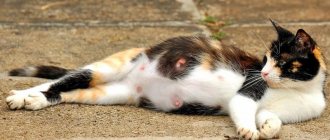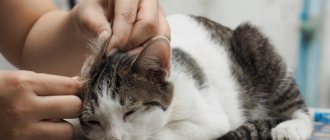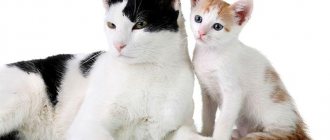What will you learn from the article?
- Russian cat breeds
- Key Features
- Russian blue cat
- Siberian
- Neva Masquerade
- Don Sphynx
- Peterbald
- Kurilian Bobtail
- Ural rex
- Altai blue-eyed
- Ussuri cat
History claims that cats spread across the territory of the Russian Federation simultaneously with the settlement of areas by tribes. Only towards the end of the 20th century did targeted work on breeding cat breeds begin; disputes about the belonging of some types of breeds to Russian selection are still ongoing today.
A cat worth its weight in silver
Philip Budkin.
Girl in front of a mirror. 1848. National Art Museum of the Republic of Belarus, Minsk, Belarus The first cats were brought by sailors to Russia in the pre-Christian era. Exotic animals were a valuable commodity: the value of a cat until the 15th century was comparable to the value of a healthy arable animal - an ox. They paid for the cat in hryvnias - silver bars of 205 grams. If you killed someone else's animal, accidentally or maliciously, you had to pay its owner compensation - one hryvnia and a healthy animal in return for the killed one.
“If someone kills a dog or a cat, the blame is on the hryvnia, and the dog belongs to the dog, and the cat belongs to the cat.”
Collection of laws “Metropolitan Justice”, XIII century
Fact No. 4: in the 14th century, seals were valued several times more expensive than cows and on a par with dogs.
The so-called “Metropolitan Justice”, a legal monument of the 14th-15th centuries, lists the following fines for theft:
“...for a cat 3 hryvnia, for a dog 3 hryvnia, for a mare 60 kun, for an ox 3 hryvnia, for a cow 40 kun, for a third 30 kun, for a hollow half a hryvnia, for a calf 5 kun, for a boran nogata, for a pig nogot, for for a sheep 5 kun, for a stallion hryvnia, for a foal 6 nails”[5].
If we consider a kuna equal to 1/50 of a hryvnia [6], then 3 hryvnia = 150 kuna, which is almost 4 times more than what was demanded for a cow. Even if we take the earlier “rate” of the 11th century - 3 hryvnia = 75 kunas, then this amount is almost 2 times more than the fine for a cow. Surprisingly, the cat was valued as highly as the dog and ox, which were much more closely involved in the human economy. Such a fine looks even more strange if we take into account our assumption that cats survived in ancient Russian cities on their own and were “yard servants”. Maybe the church representatives had some special purebred cats living with them? The source says nothing about this.
The only animal in the temple
Ivan Bilibin. Scientist cat. Frontispiece to “The Tale of the Golden Cockerel” by Alexander Pushkin. 1910. Private collection
In the Catholic countries of medieval Europe, cats were considered minions of witches and servants of the devil - especially black ones - and were burned at the stake. In Orthodox countries, they were treated exactly the opposite. In Rus', a cat was considered a pure animal. Of all the animals, only she was allowed to enter the temple. In addition, cats saved the bins of churches and monasteries from rodents, which provided them with the patronage of priests for many years.
Portrait of a royal cat
Vaclav Hollar. An authentic portrait of the cat of the Grand Duke of Muscovy. 1663. National Library of France, Paris, France
Cats also took root at court. They lived in the royal chambers, and even painted portraits of some of them. In 1661, the Dutch artist Frederic Moucheron created a portrait of Tsar Alexei Mikhailovich's cat. The Hermitage houses an engraving made from this drawing by the Czech artist Vaclav Hollar. For a long time it was believed that it was created during the time of Ivan the Terrible, but this was refuted by collector and art historian Dmitry Rovinsky. In 1884, he described the engraving in his book “Materials for Russian Iconography”: “This leaf is very rare. Chizhev saw a copy of this cat in Dresden, without a year, cut off from the bottom, and therefore attributed it to Tsar Ivan the Terrible; Snegirev repeated this mistake in his Popular Pictures.”
To protect barns and deter mice
Vyacheslav Schwartz. Scene from the home life of the Russian Tsars (Chess game). 1865. State Russian Museum, St. Petersburg
Alexei Mikhailovich's son Peter I considered cats to be animals that could be useful. In one of the decrees, he ordered “to have cats in the barns, to protect them, and to intimidate mice and rats.” Peter I's favorite cat was named Vasily. The Tsar took it in 1724 from the house of a Dutch merchant who traded in Vologda - Peter the Great often visited him.
Ratcatcher cats from Kazan
Pavel Fedotov. The Major's Matchmaking, or Correcting Circumstances by Marriage. 1848–1849. State Tretyakov Gallery, Moscow
The cat campaign against pests was continued by Empress Elizaveta Petrovna. In 1745, the Empress ordered 30 kept (castrated) rat-catching cats to be sent especially for the Winter Palace. The cats were brought from Kazan: it was believed that Kazan cats were skilled rodent hunters.
“... Having found in Kazan the best and largest thirty cats of the local breeds, convenient for catching mice, send them to St. Petersburg to the court of Her Imperial Majesty... And if anyone has such stored cats, they would be announced for speedy departure the provincial chancellery, of course, from publication within three days, fearing for failure to announce who has them, and who does not announce them, a fine according to the decrees ... "
“Decree on the expulsion of cats to the courtyard,” 1745
Don Sphynx
The first kitten of the Don Sphynx with a bald back was taken from children on the street by a resident of Rostov-on-Don; the first offspring of the cat Varvara was also hairless, which gave rise to the development of a new breed. As a result of further breeding, another line of Sphynxes appeared, unrelated to the Canadian ones.
Representatives of this breed at first glance are very similar to their foreign counterparts, but a professional breeder or an experienced fancier will immediately notice the differences due to a different set of genes.
Kittens can be born completely bald, covered with short down or dense thick hair. The body structure is also lighter compared to Canadians, this breed is distinguished by a different eye shape and other little details, this is a real Russian breed that has earned worldwide recognition.
A kitten can be purchased for 9-30 thousand rubles.
Art gallery security guards
Nikolai Bodarevsky. Favorite. 1905. Private collection
Catherine the Great did not like cats, but she could not do without them. The Empress not only did not eliminate the cats from the Hermitage, but also gave them a new status as “guards of art galleries.” The Empress ordered: “...to divide the cats into indoor and outdoor cats, and in order to know the number of the first and second, entrust keeping records.” Those who were good at catching mice and at the same time were good-looking were taken into the “room” ones - these were mainly Russian Blue cats.
Fact No. 2: the first mention of seals in the chronicles is related to the fact that they were... eaten.
Sadly, seals are most often mentioned in written sources as food. Of course, in ordinary life they were not eaten - this happened only in an emergency: during famine. The Novgorod First Chronicle describes the terrible events of 1230 as follows: “and the troupe was circumcised by Judahou. and drowsii koninou, psinou. cats. nb those osochishche tako tvoryahou” (NPL, 113 vol.).
The fact that the townspeople started eating cats shows that they had no other food left. This terrible mention (probably the oldest in written sources) dates back to the middle of the 13th century, when the text of the chronicle was written. In general, cat meat was considered unclean, and eating it, according to medieval scribes, was a sign of savagery. Thus, in the Laurentian Chronicle one can find the following description of the wicked tribe: “I eat every kind of filth. mosquitoes and flies. kotki (this form of the word was used on a par with the familiar “cat.” – Ed.), serpent. and a dead man is not a cellar” (LL 1377, 85 a (1096)).
Cats in Russian proverbs
Ivan Gorokhov. At the convalescent bedside. 1886. Buryat Republican Art Museum named after Ts.S. Sampilova, Ulan-Ude
By the end of the 18th century, cats ceased to be “piece goods”. Now they lived not only at churches and in the houses of rich people, but also in the huts of peasants. This was also reflected in folklore. In 1853, the Russian naturalist, writer and linguist Vladimir Dal published a two-volume book “Proverbs of the Russian People” - cats were mentioned in 75 of them.
It’s not all about Maslenitsa; there will be Lent too. Even the cat might jump off the stove. Get out of the stove, cat: you need to dry them. The dog eats crumbs under the table, and the cat waits for spilled milk. If you kill a cat, you won’t see any luck in anything for seven years. He, like a cat, always falls on his feet.
Fact No. 1: In Ancient Rus', seals were introduced in the 9th-10th centuries.
The question of when cats were first introduced in Ancient Rus' can be answered by archeology. On the territory of the Rurik settlement, three kilometers from the center of Veliky Novgorod, scientists discovered fragments of the skeletons of six cats in the layers of the 9th-10th centuries. Cats were probably not yet widespread at that time (compare the number of cat bones with the number of dog bones according to the table). Thanks to the finds of archaeologists, we can confidently say that cats definitely lived in the houses of the Russians (and both representatives of the elite lived at the Rurik settlement - the prince and his squad, as well as service personnel) already during the formation of the Old Russian state - that is, during the times of the Prophetic Oleg, Olga and Svyatoslav. As for the keeping of these animals by peasants, we are forced to shrug our shoulders - no traces of the life of cats in the villages have yet been found. However, it must be noted that rural settlements in Eastern Europe have been studied quite poorly, and new discoveries may still await us.
“Like a sport - who has the fatter cat”
Boris Kustodiev. Merchant's wife having tea. 1918. State Russian Museum, St. Petersburg
In cities, cats “worked” mainly in markets. They lived freely and well-fed. Journalist Vladimir Gilyarovsky wrote in his book “Moscow and Muscovites” that the cats of Okhotny Ryad were especially well-fed. Local merchants protected valuable custodians of goods. They were even allowed to sit on the counters during breaks between hunting rodents.
“...The first thing they ordered was to have cats in all shops. But cats were already in most shops. It was like a sport to see who has the fatter cat. Well-fed, huge cats sat on the counters.”
Vladimir Gilyarovsky, “Moscow and Muscovites”
Fact No. 3: cats in Rus' lived in cities and were smaller than their modern counterparts.
The cats of Ancient Rus' were city dwellers. The remains of their bones were found by archaeologists in Kyiv, Old Ryazan, Novgorod, Tver, Yaroslavl, Smolensk[1] and other cities. Researchers believe that these were rather small animals: the average height at the withers did not exceed 30 cm, and ancient Russian cats weighed no more than 4 kg[2]. Although there were exceptions: at the Trinity excavation site in Novgorod, the heel bone of a real giant was found. Its size is larger than average not only for a domestic cat, but also for a wild one. One can only guess where the giant cat came from in the city. Perhaps this is still a wild cat, caught by Novgorodians while hunting, perhaps a domestic cat, donated or brought by foreign merchants.
There is also no clarity about what breeds of cats lived in Ancient Rus'. Firstly, according to researchers, it cannot be argued that in the Middle Ages anyone was specifically involved in the selection and breeding of these animals[3]. Secondly, based on osteological, i.e., bone material (and only this is preserved), it is impossible to judge such important characteristics of the breed as the color and density of fur, temperament, and the ability to catch mice, finally. Most likely, seals in medieval Russian cities lived almost independently and obtained their own food. And no delicacies from your kind owner or periodic trips to the veterinarian. Cat life was filled with hunger and danger - many animals died (or were killed) at a young age. Judging by the marks on the bones, some cats were skinned after death[4] - even a dead animal could be used on the farm. It turns out that the owners were pragmatic about their pets and did not care about them too much. The more surprising is the following fact.
Cats of besieged Leningrad
Pavel Kondratyev. Street of the besieged city (fragment). From the series “Blockade”. 1942. Museum of Fine Arts of the Republic of Karelia, Petrozavodsk
During the years of the siege, almost all Leningrad cats either died or were eaten. Therefore, rats quickly multiplied in the city. In April 1943, 5 thousand smoky cats were brought to Leningrad from Yaroslavl, and then another train of cats from Siberia. Soviet writer Leonid Panteleev wrote in his diary during the siege: “A kitten in Leningrad costs 500 rubles.” For comparison: a kilogram of bread was bought by hand for 50 rubles, and a watchman earned 120 rubles. The four-legged fighters were sent to museums and basements of surviving residential buildings. After some time, they cleared the city of rodents.
Cat as an attraction
Ekaterina Kachura-Falileeva. At the samovar. 1st half XX century
Cats still “work” in the Hermitage - not in the exhibition halls, but in the courtyards and basements. Each cat has a veterinary passport, a bowl and a basket for sleeping. In 2016, the British publication The Telegraph included the Hermitage cats in the list of unusual attractions that you must see if you come to St. Petersburg.
“There are only 50 cats, I set this limit myself. They live in the yard and in basements. We give “extra” cats to good hands. They know their habitats in the basements; there is no need to guide them. We have interviews and filming about cats no less often than about Rembrandt.”
Director of the Hermitage Mikhail Piotrovsky, Literaturnaya Gazeta, 2014











